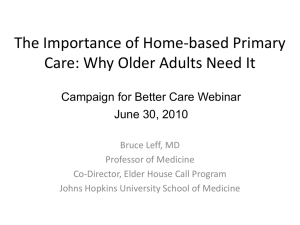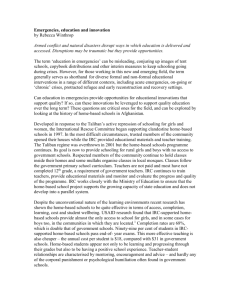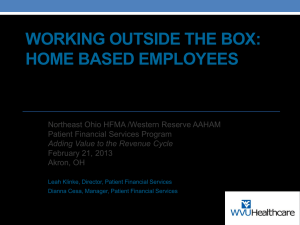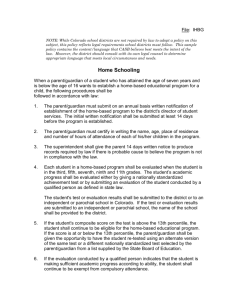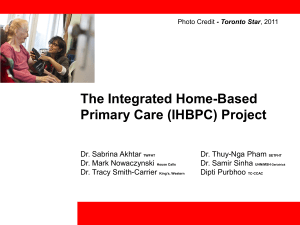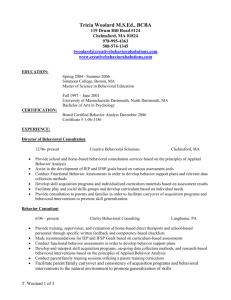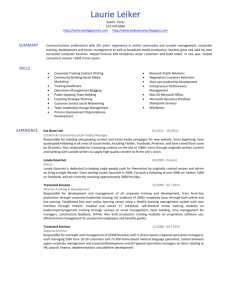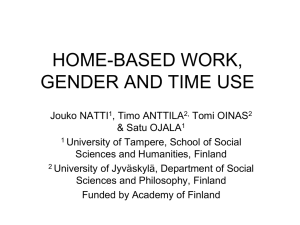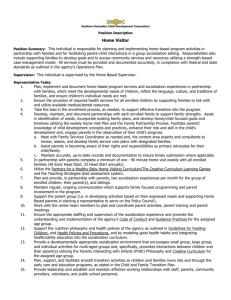NORTHPOINTE BEHAVIORAL HEALTHCARE SYSTEMS
advertisement
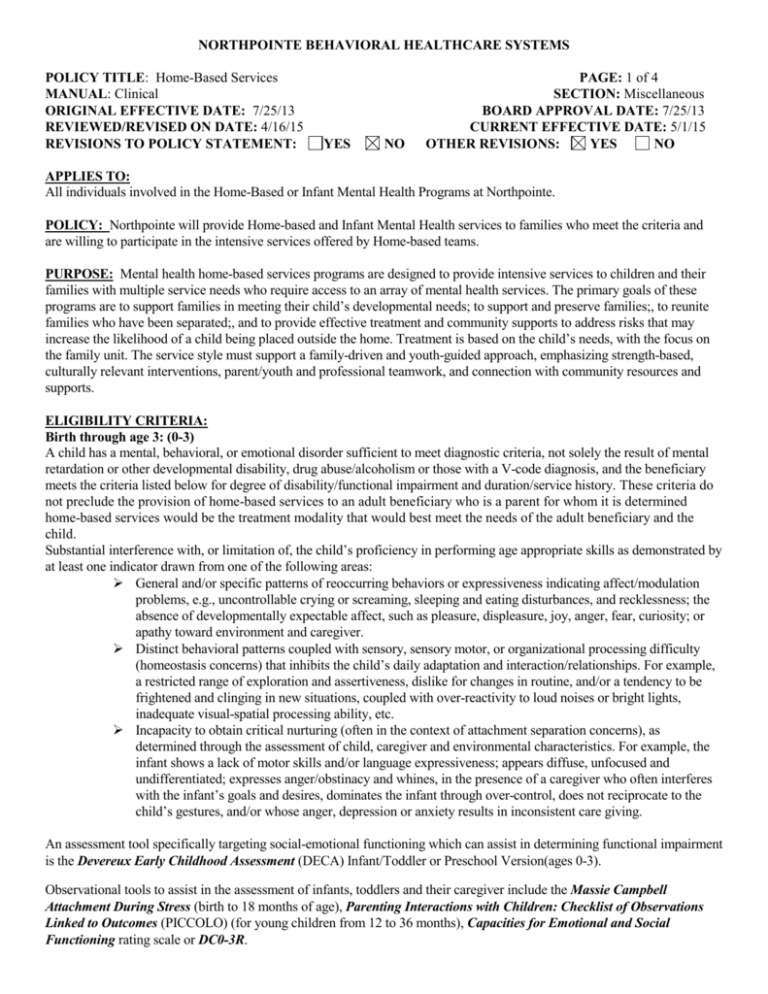
NORTHPOINTE BEHAVIORAL HEALTHCARE SYSTEMS POLICY TITLE: Home-Based Services MANUAL: Clinical ORIGINAL EFFECTIVE DATE: 7/25/13 REVIEWED/REVISED ON DATE: 4/16/15 REVISIONS TO POLICY STATEMENT: YES NO PAGE: 1 of 4 SECTION: Miscellaneous BOARD APPROVAL DATE: 7/25/13 CURRENT EFFECTIVE DATE: 5/1/15 OTHER REVISIONS: YES NO APPLIES TO: All individuals involved in the Home-Based or Infant Mental Health Programs at Northpointe. POLICY: Northpointe will provide Home-based and Infant Mental Health services to families who meet the criteria and are willing to participate in the intensive services offered by Home-based teams. PURPOSE: Mental health home-based services programs are designed to provide intensive services to children and their families with multiple service needs who require access to an array of mental health services. The primary goals of these programs are to support families in meeting their child’s developmental needs; to support and preserve families;, to reunite families who have been separated;, and to provide effective treatment and community supports to address risks that may increase the likelihood of a child being placed outside the home. Treatment is based on the child’s needs, with the focus on the family unit. The service style must support a family-driven and youth-guided approach, emphasizing strength-based, culturally relevant interventions, parent/youth and professional teamwork, and connection with community resources and supports. ELIGIBILITY CRITERIA: Birth through age 3: (0-3) A child has a mental, behavioral, or emotional disorder sufficient to meet diagnostic criteria, not solely the result of mental retardation or other developmental disability, drug abuse/alcoholism or those with a V-code diagnosis, and the beneficiary meets the criteria listed below for degree of disability/functional impairment and duration/service history. These criteria do not preclude the provision of home-based services to an adult beneficiary who is a parent for whom it is determined home-based services would be the treatment modality that would best meet the needs of the adult beneficiary and the child. Substantial interference with, or limitation of, the child’s proficiency in performing age appropriate skills as demonstrated by at least one indicator drawn from one of the following areas: General and/or specific patterns of reoccurring behaviors or expressiveness indicating affect/modulation problems, e.g., uncontrollable crying or screaming, sleeping and eating disturbances, and recklessness; the absence of developmentally expectable affect, such as pleasure, displeasure, joy, anger, fear, curiosity; or apathy toward environment and caregiver. Distinct behavioral patterns coupled with sensory, sensory motor, or organizational processing difficulty (homeostasis concerns) that inhibits the child’s daily adaptation and interaction/relationships. For example, a restricted range of exploration and assertiveness, dislike for changes in routine, and/or a tendency to be frightened and clinging in new situations, coupled with over-reactivity to loud noises or bright lights, inadequate visual-spatial processing ability, etc. Incapacity to obtain critical nurturing (often in the context of attachment separation concerns), as determined through the assessment of child, caregiver and environmental characteristics. For example, the infant shows a lack of motor skills and/or language expressiveness; appears diffuse, unfocused and undifferentiated; expresses anger/obstinacy and whines, in the presence of a caregiver who often interferes with the infant’s goals and desires, dominates the infant through over-control, does not reciprocate to the child’s gestures, and/or whose anger, depression or anxiety results in inconsistent care giving. An assessment tool specifically targeting social-emotional functioning which can assist in determining functional impairment is the Devereux Early Childhood Assessment (DECA) Infant/Toddler or Preschool Version(ages 0-3). Observational tools to assist in the assessment of infants, toddlers and their caregiver include the Massie Campbell Attachment During Stress (birth to 18 months of age), Parenting Interactions with Children: Checklist of Observations Linked to Outcomes (PICCOLO) (for young children from 12 to 36 months), Capacities for Emotional and Social Functioning rating scale or DC0-3R. NORTHPOINTE BEHAVIORAL HEALTHCARE SYSTEMS POLICY TITLE: Home-Based Services PAGE: 2 of 4 MANUAL: Clinical SECTION: Miscellaneous ORIGINAL EFFECTIVE DATE: 7/25/13 BOARD APPROVAL DATE: 7/25/13 REVIEWED/REVISED ON DATE: 4/16/15 CURRENT EFFECTIVE DATE: 5/1/15 Other assessment tools may be utilized by the practitioner based on the needs of the infant/toddler or parent(s). The very young age and rapid transition of infants and toddlers through developmental stages makes consistent symptomatology over time unlikely. However, indicators that a disorder is not transitory and will endure without intervention include: The infant/toddler disorder(s) is affected by persistent multiple barriers to normal development (regulatory disorders, inconsistent care giving, chaotic environment, etc.); or Infant/toddler did not respond to less intensive, less restrictive intervention, when lessor intensive service options are available. Age four though six (4-6) Decisions regarding whether a child age four through six is seriously emotionally disturbed and in need of home-based services and supports utilize similar dimensions to older children. The dimensions include a diagnosable behavioral or emotional disorder, substantial functional impairment/limitation of major life activities, and duration of condition. However, as with younger children birth through age three, assessment must be sensitive to the critical indicators of development and functional impairment for the age group. Significant impairments in functioning are revealed across life domains in the child’s expression of affect/self-regulation, social development (generalization of attachment beyond parents, capacity for peer relationships and play, etc.), physical and cognitive development, and the emergence of a sense of self. All of the dimensions must be considered when determining if a child is eligible for home-based services. A child has a mental, behavioral or emotional disorder sufficient to meet diagnostic criteria specified within the current version of the DSM or ICD not solely the result of mental retardation or other developmental disability, drug abuse/alcoholism or those with a V-code diagnosis, and the beneficiary meets the criteria listed below for degree of disability/functional impairment and duration/service history. Substantial interference with, or limitation of, the child’s proficiency in performing age appropriate skills across domains and/or consistently within specific domains as demonstrated by at least one indicator drawn from at least two of the following areas: Impaired physical development, sensory, sensory motor or organizational processing difficulty, failure to control bodily functions (e.g., bed wetting). Limited cognitive development, as indicated by restricted vocabulary, memory, cause and effect thinking, ability to distinguish between real and pretend, transitioning from self-centered to more reality-based thinking, etc. Limited capacity for self-regulation, inability to control impulses and modulate anxieties as indicated by frequent tantrums or aggressiveness toward others, prolonged listlessness or depression, inability to cope with separation from primary caregiver, inflexibility and low frustration tolerance, etc. Impaired or delayed social development, as indicated by an inability to engage in interactive play with peers, inability to maintain placements in day care or other organized groups, failure to display social values or empathy toward others, absence of imaginative play or verbalizations commonly used by preschoolers to reduce anxiety or assert order/control on their environment, etc. Care-giving factors which reinforce the severity or intractability of the childhood disorder and the need for multifaceted intervention strategies (e.g., home-based services) such as a chaotic household/constantly changing care-giving environments, inappropriate caregiver expectations, abusive/neglectful or inconsistent care-giving, occurrence of traumatic events, subjection to others’ violent or otherwise harmful behavior. The standardized assessment tool specifically targeting social-emotional functioning for children 4 through 6 years of age recommended for use in determining degree of functional impairment is the Pre-School and Early Childhood Functional Assessment Scale (PECFAS). A total impairment score of 80 or more on the PECFAS would be an indication of homebased services need. The following specify length of time criteria for determining when the child’s functional disabilities justify their referral for home-based services: Evidence of three continuous months of illness; NORTHPOINTE BEHAVIORAL HEALTHCARE SYSTEMS POLICY TITLE: Home-Based Services PAGE: 3 of 4 MANUAL: Clinical SECTION: Miscellaneous ORIGINAL EFFECTIVE DATE: 7/25/13 BOARD APPROVAL DATE: 7/25/13 REVIEWED/REVISED ON DATE: 4/16/15 CURRENT EFFECTIVE DATE: 5/1/15 Three cumulative months of symptomatology/dysfunction in a six-month period; or Conditions that are persistent in their expression and are not likely to change without intervention. Age six through seventeen (6-17) Decisions regarding whether a child or adolescent has a serious emotional disturbance and is in need of home-based services is determined by using the following dimensions: the child has a diagnosable behavioral or emotional disorder, substantial functional impairment/limitation of major life activities, and duration of the condition. For children age seven to seventeen, the Child and Adolescent Functional Assessment Scale (CAFAS) is used to make discriminations within the functional impairment dimension. All of the dimensions, as well as family voice and choice, must be considered when determining if a child is eligible for home-based services. The child/adolescent currently has, or had at any time in the past, a diagnosable behavioral or emotional disorder of sufficient duration to meet diagnostic criteria specified within the current version of the DSM or ICD, excluding those with a diagnosis other than, or in addition to, alcohol or drug disorders, a developmental disorder, or social conditions (V codes). For purposes of qualification for home-based services, children/adolescents may be considered markedly or severely functionally impaired if the minor has: An elevated subscale score (20 or greater) on at least two elements of the Child/Adolescent Section of the CAFAS; or An elevated subscale score (20 or greater) on one element of the CAFAS Child/Adolescent Section, combined with an elevated subscale score (20 or greater) on at least one CAFAS element involving Caregiver/Care-giving Resources; or A total impairment score of 80 or more on the CAFAS Child/Adolescent Section. The following specify the length of time the youth’s functional disability has interfered with his daily living and led to his referral for home-based services: Evidence of six continuous months of illness, symptomatology, or dysfunction; Six cumulative months of symptomatology/dysfunction in a 12-month period; or On the basis of a specific diagnosis (e.g., schizophrenia), disability is likely to continue for more than one year. PROCEDURES: The plan of service for youth receiving home-based services must also include individualized crisis and safety plans that explicitly outline responses to family-specific crisis situations and safety risks and delineate who, including the family and others, is accountable for the various responses identified. The crisis and safety plan should be completed within 30 days of the case opening in Home Based. Home-based services may be provided to an adult beneficiary who is a parent for whom it is determined home-based services would be the treatment modality that would best meet the needs of the adult beneficiary and the child. This would include a parent who has a diagnosis within the current version of the Diagnostic and Statistical Manual of Mental Disorders (DSM) or International Classification of Diseases (ICD) that results in a care-giving environment that places the child at-risk for serious emotional disturbance. A minimum of four hours of individual and/or family face-to-face home-based services per month will be provided by the primary home-based services worker or, if appropriate, the evidence-based practice therapist. In addition, it is expected that adequate collateral contacts, including non-face-to-face collateral contacts, with school, caregivers, child welfare, court, psychiatrist, etc., will be provided to implement the plan of service. The amount and scope of home-based services to families as they transition out of home-based services into a less intensive service or to case closure can be determined by family-driven and youth-guided decision making to maintain continuity of treatment and ensure stability. Variation from the required intensity of services for families transitioning out of home-based NORTHPOINTE BEHAVIORAL HEALTHCARE SYSTEMS POLICY TITLE: Home-Based Services PAGE: 4 of 4 MANUAL: Clinical SECTION: Miscellaneous ORIGINAL EFFECTIVE DATE: 7/25/13 BOARD APPROVAL DATE: 7/25/13 REVIEWED/REVISED ON DATE: 4/16/15 CURRENT EFFECTIVE DATE: 5/1/15 services must be documented in the plan of service. This transition period is not to exceed three months. Crisis intervention services must be available 24 hours a day, 7 days a week, via availability of home-based services staff or agency on-call staff. If after-hours crisis intervention services are provided to a family by staff other than the primary homebased services worker, the on-call staff will have access to information about any impending crisis situations and the family’s crisis and safety plans. Home-based services staff must receive weekly clinical supervision (one-on-one and/or group) to help them navigate the intense needs of the families receiving home-based services. Evidence of the provision of this clinical supervision must be recorded via supervision logs, sign–in sheets, or other methods of documentation. Services are provided in the family home or community. Any contacts that occur other than in the home or community must be clearly explained in case record documentation as to the reason, the expected duration, and the plan to address issues that are preventing the services from being provided in the home or community. TEAM COMPOSITION: The maximum full-time home-based services worker-to-family ratio is 1:12. This can be adjusted to accommodate families transitioning out of home-based services. The maximum worker-to-family ratio in those circumstances is 1:15 (12 active/3 transitioning). STAFF QUALIFICATIONS: Properly credentialed staff must deliver home-based services. Home-based services professional staff must meet the qualifications of a child mental health professional. The initial training curriculum and 24 hours of annual child-specific training for home-based services staff should be relevant to the age groups served and the needs of the children and families receiving home-based services. For home-based services programs serving infants/toddlers (birth through age three) and their families, staff must be trained in infant mental health interventions and, effective October 1, 2009, must minimally have Endorsement Level 2 by the Michigan Association of Infant Mental Health; Level 3 is preferred. Staff may receive an IMH waiver on an annual basis while obtaining training for the IMH endorsement. For home-based services programs serving children with developmental disabilities, the child mental health professional must meet the qualifications, as defined above, and also be a Qualified Mental Retardation Professional (QMRP). Trained paraprofessional assistants may assist home-based services professional staff with implementation of treatment plan behavioral goals related to positive skill development and development of age-appropriate social behaviors. Services to be provided by the home-based services assistant must be identified in the family plan of service, must relate to identified treatment goals, and must be under the supervision of relevant professionals. Home-based services assistants must be trained regarding the beneficiary’s treatment plan and goals, including appropriate intervention and implementation strategies, prior to beginning work with the beneficiary and family. Activities of home-based services assistants do not count as part of the minimum four hours of face-to-face home-based services provided by the primary home-based services worker per month. The home-based services assistant’s face-to face time would be in addition to hours provided by the primary home-based services worker. REFERENCES: Michigan Medicaid Provider Manual, April 1, 2015 edition, p. 36-42.
